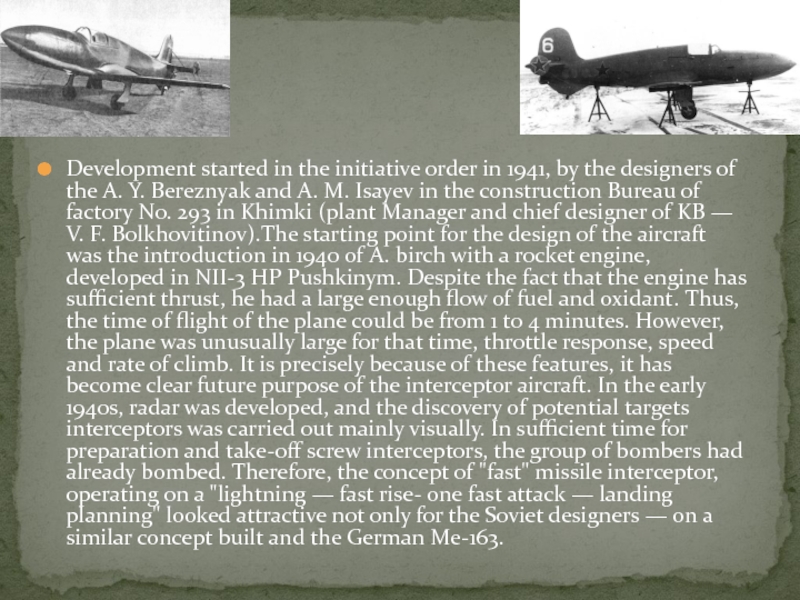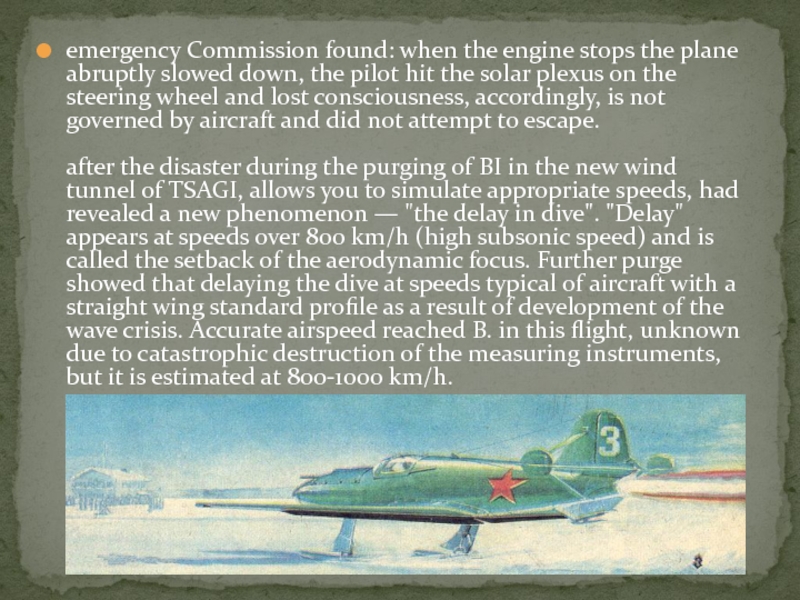Слайд 2The appearance of the aircraft
Слайд 3BI (BI — Bereznyak-Isayev, middle or Fighter, also known under
the name "b-1") — rocket aircraft, the first Soviet aircraft
with liquid rocket engine. Monoplane with low wing, a launch mass of 1.5 tons when the supply of fuel (nitric acid and kerosene) 500 kg, wing Span of 7.5 m.
Слайд 4Development started in the initiative order in 1941, by the
designers of the A. Y. Bereznyak and A. M. Isayev
in the construction Bureau of factory No. 293 in Khimki (plant Manager and chief designer of KB — V. F. Bolkhovitinov).The starting point for the design of the aircraft was the introduction in 1940 of A. birch with a rocket engine, developed in NII-3 HP Pushkinym. Despite the fact that the engine has sufficient thrust, he had a large enough flow of fuel and oxidant. Thus, the time of flight of the plane could be from 1 to 4 minutes. However, the plane was unusually large for that time, throttle response, speed and rate of climb. It is precisely because of these features, it has become clear future purpose of the interceptor aircraft. In the early 1940s, radar was developed, and the discovery of potential targets interceptors was carried out mainly visually. In sufficient time for preparation and take-off screw interceptors, the group of bombers had already bombed. Therefore, the concept of "fast" missile interceptor, operating on a "lightning — fast rise- one fast attack — landing planning" looked attractive not only for the Soviet designers — on a similar concept built and the German Me-163.

Слайд 5aircraft, the characteristics of stability and controllability are consistent with
the design.In October 1941 a decision was made to evacuate
the factory No. 293 in the Urals. On 7 November, the staff of the plant began production in the village of bilimbay (G. O. Pervouralsk, 60 km West of Sverdlovsk). By December 1941, the lapping of the aircraft continued at the new location.The main forces of the KB and was thrown to the refinement of the engine D-1-A-1100 as the group L. S. Dushkin at NII-3 were already busy developing the engine for a new rocket plane, the NII-3 — 302. From KB Bolkhovitinov directed the work of A. E. Roslyakov, from research-3 — A. V. Pallo (he worked Bilimbai until the end of 1942, then was withdrawn in NII-3). Instead ill test pilot B. N. Kudrin, the air force sent G. Ya. Bakhchivandzhi.20 February 1942 during operation of the engine on the stand there was an explosion. It has affected A.V. Pallo and G. Ya. Bakhchivandzhi been damaged by the stand and engine. However, in March the test was continued.On 25 April 1942 the aircraft was relocated to the airfield of the air force research Institute near the town of Koltsovo (80 km from Bulimba and Pervouralsk). April 30 was carried out a trial of the engine, may 2 — run airfield, may 13 — approaching a length of about 50 m at a height of about 1 m.May 15, 1942 BI-plane 1, under the management of G. Ya. Bakhchivandzhi first flew using a rocket engine. The flight lasted 3 minutes 9 seconds, for 60 seconds of work LRE reached the height of 840 meters, at a maximum speed of 400 km/h and a maximum climb rate of 23 m/s.

Слайд 6For us, standing on the earth, this takeoff was unusual.
Unusual, quickly picking up speed, the plane 10 seconds off
the ground and within 30 seconds was out of sight. Only the flames of the engine were talking about where he is. So it took a few minutes. I must admit, I shook hamstring. Finally, Bakhchivandzhi returned and got to the airport.The landing was hard, one front wheel broke, the wheel bounced and rolled across the airfield.For the pilot it wasn't just the first flight on a new plane, but the flight on the new unusual qualities that demanded that he speed up all the action and thinking because of the brevity of the flight and greatly increased acceleration of the movement. The car was absolutely not like other aircraft of the time, because of this, the pilot did not fully implement the specified program, but the main thing was that he carried out this mission and safely returned.
Слайд 7After the flight it was found that during the entire
test cycle BI-1 is already quite damaged nitric acid. The
decision was made to manufacture two experimental BI and the tab is small (30-40 machines) military series BI-sun. From an experimental aircraft BI-VS different weapons: in addition to the two guns under the fuselage before the cockpit was installed cluster bomb. The cassette was placed ten small bombs with a caliber of 2.5 kg with great explosive force. The bombs were designed to reset the bombers going to build, and defeat them with shrapnel, and blast.In 1943, was carried out six flights on the second (BI-2) and three (B-3) copies of the aircraft. One of the flights were performed by K. A. Gruzdev, and the rest of G. Ya. Bakhchivandzhi. In particular, with the participation of academician A. I. Berg and B. E. Chertok was created radiopresident coordinate plane (ROX)[1].A flight mission on March 27, 1943 (seventh, sixth in 1943) was different from the previous one. If the aircraft was tested at the maximum altitude and rate of climb, but now he had to be tested at maximum speed. For this test pilot was at a constant height of 2 thousand m. to wait until the engine is turned off after fuel. From the point of view of observers with the land until cut off engine flight took place according to plan, but then the plane went into a dive and, without making attempts to get out of it, collided with the ground. Test pilot Grigory Bakhchivandzhi died.

Слайд 8emergency Commission found: when the engine stops the plane abruptly
slowed down, the pilot hit the solar plexus on the
steering wheel and lost consciousness, accordingly, is not governed by aircraft and did not attempt to escape.
after the disaster during the purging of BI in the new wind tunnel of TSAGI, allows you to simulate appropriate speeds, had revealed a new phenomenon — "the delay in dive". "Delay" appears at speeds over 800 km/h (high subsonic speed) and is called the setback of the aerodynamic focus. Further purge showed that delaying the dive at speeds typical of aircraft with a straight wing standard profile as a result of development of the wave crisis. Accurate airspeed reached B. in this flight, unknown due to catastrophic destruction of the measuring instruments, but it is estimated at 800-1000 km/h.
Слайд 9This disaster led to the cancellation of the beginning of
the production BI and destruction already inherent BI-sun.In 1943 the
plant Bolkhovitinov was returned to Moscow. It was built a few planes, but the test was hampered by the absence of the engine — the only D-1-A-1100 Dushkin was lost in the crash 27.03.43, the new NII-3 is not supplied. This led to the fact that A. Isaev was forced to develop its engine, the RD-1, representing a somewhat modified version of the D-1-A-1100. It was installed on BI-7, and twice the flight with their inclusion. In addition, it was made even more machines used in the test mode of the airframe and two ramjets DM-4 design I. A. Merkulova (they were developed as auxiliary for propeller-driven airplanes).As it appeared in the mid-1940s, jet aircraft turbojet became apparent hopelessness of further work on the rocket fighters in General, and on BI in particular, primarily because of the extremely limited flight duration.However, the experience gained in KB Bolkhovitinov while working on BI, was very helpful, and the natives of his design Bureau was later a prominent figure in the Soviet rocket and space technology. Two designers BI became the founders of two design schools: A. Y. Bereznyak founded OKB-155, which occupied the leading position in the USSR in the development of cruise missiles, and A. M. Isaev became the founder of the OKB-2, specializing in liquid rocket engines of small and average thrust for rockets and spacecraft.In all there were 9 aircraft. 1 of them was issued in Moscow, the rest was produced by the aircraft plant No. 381, located in the city of Nizhny Tagil in the territory of Uralvagonzavod (UVZ).





























